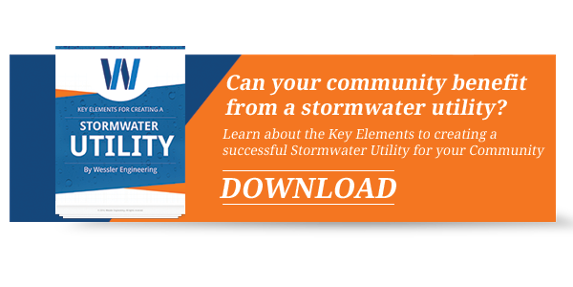Drainage problems got your community underwater? Is your storm drainage system repair list like standing water- going no where? Stormwater Utilities create a funding source for your stormwater projects. You probably have questions, so we have compiled the top 10 FAQ's when it comes to stormwater utility formation.
1. What is a stormwater utility?
A stormwater utility is a legal entity which can provide stormwater management activities including administrative functions, planning, engineering, regulation, permitting, maintenance operations, and capital improvements. The stormwater utility (like other municipal utilities) provides a method of generating revenue for these activities through user fees. Rates are most commonly based on impervious surface area measurements.
2. What is an impervious surface?
Impervious surfaces are hard surfaces (such as rooftops, streets, parking lots, driveways, patios, asphalt, concrete, compacted gravel, and other paved areas). These surfaces prevent or limit the natural entry of stormwater into the ground. When stormwater hits an impervious surface, it runs off and does not soak into the ground. Runoff can generate high volumes of water and it flows more quickly than water flowing over a vegetated surface. Runoff and stormwater flowing quickly can cause flooding. It can also cause erosion in ditches and streams when the bare soil becomes exposed.
3. How is stormwater affected by increased runoff?
With increased amounts of impervious surface, more runoff is produced and it travels at higher speeds. This runoff picks up and carries pollutants to the stormwater collection system and eventually to receiving waters (lakes, ponds, rivers and streams). Large volumes of quickly flowing runoff will also erode soil, damage plants, and cause waters to become clouded and murky with sediments.
4. How is stormwater affected by increased pollutants?
Impervious surfaces tend to collect a variety of pollutants including cleaning products; paint; oil, grease, and toxic chemicals from automobiles; road salts; pesticides and fertilizers from lawn maintenance and gardening; pet waste; litter; and eroded sediments. Increased amounts of pollutants can harm fish and wildlife, kill native plants, contaminate drinking water supplies, and make recreational areas unsafe.
5. What is an ERU?
An “Equivalent Residential Unit”, or ERU, is a common billing unit for stormwater utility fees. An ERU is a measure of the average amount of impervious surface area for a single-family residential property located in the city, town or county and can be used to assess stormwater user fees. Much like a “kilowatt” serves as the basis for electrical utility, the ERU is the base unit for a stormwater utility. Many communities have established stormwater utilities based on the ERU.
6. How do we establish the user fees?
User fees are generally established according to the amount of stormwater runoff that is generated from a property, commonly measured in proportion to the square footage of impervious area within the property. Impervious surface area measurements are converted to an ERU and then assessed a monthly fee per ERU. Below is an example of the annual revenue you could receive from your stormwater utility fees.

Although some cities, towns and counties have user fees as high as $8 or $10 a month, a more common stormwater utility user fee for a residential property in the Midwest ranges from $3 to $5 a month.
7. Why do communities form a stormwater utility?
The formation of a stormwater utility requires time and resources, but the benefits of an established utility will outweigh required efforts. We have found four primary reasons why communities have implemented a stormwater utility.
- Provides a funding source for stormwater management needs.
- Ability to comply with NPDES/MS4 permitting requirements.
- Generates immediate capital improvements due to bonding authority.
- Allows for long-term solutions with a designated revenue source.
8. Are there any disadvantages to forming a stormwater utility?
The only disadvantage to implementing a stormwater utility is the small monthly fee the community members will incur. With proper education regarding the management of a stormwater utility, the rate payers will understand the many benefits to the public.
9. How do we gain the citizens' support for the utility?
Educate! Educate! Educate! A carefully planned program and funding strategy is necessary to endure scrutiny and challenges to a stormwater utility. Perhaps the most difficult task in the formation of the stormwater utility is gaining the support from the public and substantiating its need. We have found the best way to inform the public of the importance and necessity of the fees is through education. By providing various avenues for education (We have included several suggestions for you in our Ebook that is available for download below), utility customers will realize that stormwater management is a community-wide concern similar to clean drinking water and adequate wastewater treatment and disposal.
10. Who can help me with establishing a stormwater utility?
While communities can establish stormwater utilities themselves, sometimes it helps to have people who have experience in establishing stormwater utilities. Wessler has assisted dozens of communities to establish successful stormwater utilities. Ask your stormwater engineering firm for assistance. Don't have an engineer on speed dial? Contact us now!
Establishing a stormwater utility may be the right thing for you to do within your community. As state and federal governments mandate communities separate storm and sanitary sewers and implement stormwater quality management plans to protect the environment and public health, implementing a stormwater utility provides a source of revenue and may place your community in a better position for receiving grants. Consider establishing a stormwater utility for your community.
Tags


